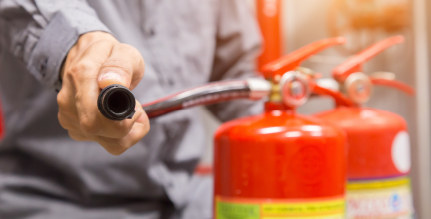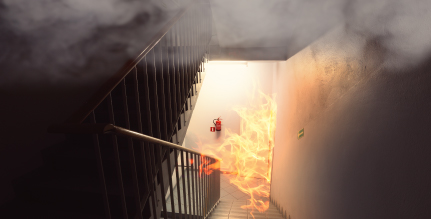Time is money, and creating a fire safety training plan as a business owner takes time. While it can seem simple to set up a quickfire safety plan, the reality is that adhering to fire safety guidelines while creating an effective plan will take both time and money. But the lives of your employees matter more than your profit margin. The U.S. Bureau of Labour Statistics stated that out of 5,333 workplace fatalities in 2019, 99 of those casualties were the result of fires in the workplace. It does not matter if you own an office, restaurant, or warehouse—fires can happen anywhere.
As a business owner, it’s important to keep the safety and security of your employees at the top of your mind. Use this guide as a simple map to outline the essentials of creating a fire safety plan for your business. The five basic elements of a fire safety training plan for businesses are evasion, discovery, signs, suppression, and constraint. Let’s begin.
What Causes Business Fires?
Fire is the result of a chemical reaction when there is a combination of fuel, oxygen, and heat all present within the same set of circumstances. An easy way to remember this is to think of these three elements of fire as a triangle. Fuel is the thing a fire needs to burn, an ignition source is what starts the fire, and oxygen is what keeps the fire burning. Oftentimes, workplace fires are caused by a machinery malfunction or misuse, but they can also be caused by electrical problems or improper use of open flames.

Steps for Preventing and Containing a Fire
-
Evasion
Fire can be tragic, and not all fires can be evaded easily, if at all. A very crucial step in fire protection is fire evasion. Your safety plan needs an evasive strategy to help employees out and away from danger. Emergency exits are crucial here because they provide the main form of escape from a fire. This also means that exit signs, backup lights, exit windows, and ladders (if you have any) need to be up to code and always ready for inspection. Since doors are going to be the main exit from any building, they need to be clear of any obstacles, and of any devices that may prevent a smooth exit.
-
Discovery
Just like how the bell at school alerted you to when class was over, you also need a system in place to alert you to when a fire has started. You need to install a fire alarm system. A few of the necessary components are: a fire alarm control panel, pull stations, smoke detectors, audible devices, and communicators.
-
Signs
Fires can happen at any time without warning, so your safety plan needs to be able to properly train employees to clearly identify the ignition sources in your place of business. Fire safety begins by discussing the basic elements of fire. The way you apply those basics is by teaching employees to use their five senses for signs of fire. For your sense of sight, watch out for a smoke. For your sense of touch, feel for heat, especially for doorknobs. For your sense of smell, be vigilant of a burning smell. For your sense of hearing, listen to the sound of cracking, the sound of sirens, other people, etc.
-
Suppression
Sometimes escape may not be an option, and so you need to properly train your employees to fight the fire. This is crucial because, in the worst-case scenario, this could mean life or death. You definitely need to train employees on how to use a fire extinguisher, using a common acronym among firefighters known as the P.A.S.S. technique (pull the pin, aim at the base, squeeze the lever gently, sweep from side to side). You can review this technique and implement some basic fire-fighting techniques. Finally, get a suppression system so that in the event of a fire, you can reduce damage to your place of business, be up to legal code, and more significantly, save the lives of your employees.
-
Constraint
Not all fires were created equal, and no one business is the same, thus, it is vital to learn about the different types of fires. There are five classes of fire:
- Class A (Normal Combustibles) – wood, paper, etc.
- Class B (Flammable Liquids) – gasoline, oil, etc.
- Class C (Electrical Equipment) – wiring, outlets, and appliances.
- Class D (Combustible Metals) – magnesium, sodium, etc.
- Class K (Cooking oil and fats) – mostly in commercial cooking.

Secure Your Commercial Property with Mesa Alarms
At Mesa Alarm Systems we understand the complexity of providing a safe environment for your business and the employees within. We can provide a plan for your fire safety needs. This can be a stand-alone fire alarm system or the monitoring of your fire suppression system (sprinkler system). We can provide the testing, monitoring, and certification of the systems to meet local code requirements.
We also provide other systems to enhance the safety of your business to include cameras systems, access control, and burglar alarm system. Call us today to provide a free consultation.
Learn more about our products and services today by calling (281) 694-4313.



